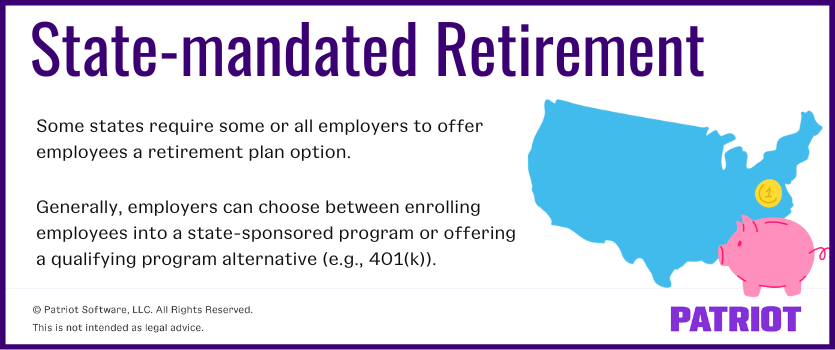State-mandated retirement plans are here to nudge (erhm, push) employers into helping employees save for their future. But, all the different rules and regulations can cause you to trip on your way to offering retirement plans.
Don’t get tripped up. We’re here to help you understand your responsibilities. Read on to learn about states with mandatory retirement plans and the specifics of each program.
What are state-mandated retirement plans?
A state-mandated retirement plan is when a state requires eligible employers to offer their employees a retirement plan option. Generally, employers can choose between enrolling employees into a state-sponsored program or offering a qualifying retirement plan (e.g., 401(k)). Employers who enroll employees in the state retirement program do not contribute to employee accounts.

State-sponsored retirement programs are typically Roth individual retirement accounts (IRAs). Employees fund Roth IRAs with after-tax dollars, so they don’t need to pay taxes when withdrawing retirement funds. Employees elect to participate and can choose how much they want to contribute. Employers then withhold employee contributions from each paycheck and remit to the employee’s account.
You are not the plan sponsor if you enroll employees in a state-sponsored retirement program. The state oversees the program. You simply handle contributions and remittances, along with any related administrative responsibilities.
Failure to comply with your state’s mandatory retirement plan may result in penalties in the hundreds or thousands, depending on the state.
Are employers required to offer 401(k) plans?
You may be wondering, Is 401(k) mandatory for employers to offer? The answer depends on your state, along with factors such as your:
- Number of employees
- Length of time in business
- Current retirement program (if applicable)
For a more in-depth look at whether you need to offer employees a 401(k) or another qualifying retirement plan, understand your state requirements (which we’ll get to later).
What are qualifying retirement plan alternatives?
Already offer a retirement plan? Great! It may satisfy your state’s requirements. Again, mandatory retirement laws by state require that you either enroll employees in your state program or offer a qualifying retirement plan.
Qualifying retirement plans may include:
- 401(k) plans
- SIMPLE IRA plans
- Qualified annuity plans
- Simplified Employee Pension plans
| Want to set up a 401(k) plan for your business instead of facilitating the state program? Patriot has partnered with Vestwell to offer affordable retirement plans for small businesses that integrate with our payroll software. You can learn more or get started here. |
Benefits of mandatory retirement plans
Quick, pause that eye roll! State-sponsored retirement programs may feel overwhelming now, but they also come with a slew of benefits for both you and employees.
Offering a retirement program can:
- Boost your employer brand by adding a new benefit
- Attract new hires and keep you competitive
- Help employees save for retirement
- Score you 401(k) tax credits (if you start a new 401(k) plan and/or add an automatic enrollment feature)
Remember that there are typically costs associated with retirement plans—both state-sponsored programs and individual plans. For example, some states have an annual report filing fee employers must pay.
States with mandatory retirement plans
Only about 10% of employees at small businesses have a retirement plan. Yikes. If you think that stat is low, you’d be correct. It is low, which is why states are lining up to implement mandatory retirement plans.
But like anything new, state-mandated retirement plans lead to confusion for employers, especially small employers. Because being an expert on state laws is, well, hard. And when you’re juggling a million other things in your business, it might feel downright impossible.
So, we’re here to bring you the basics of state-mandated retirement plans.
Below is a list of states that require retirement plans, along with states that passed legislation and are working on implementing plans soon.
If you don’t see your state, hang tight. It may pass a law to implement a state-mandated retirement program sooner rather than later.
California
CalSavers is the name of California’s state-mandated retirement program. Through CalSavers, employees can contribute to a personal Roth IRA.
Employers with five or more employees must participate in CalSavers or offer a qualifying retirement plan alternative.
The deadline for enrolling in CalSavers or offering an alternative has passed. All employers with five or more employees should be compliant.
Check out California’s retirement plan website for more information.
Colorado
The Colorado Secure Savings Program is an upcoming state-mandated retirement program. Currently, the state is finalizing rules for enrollment in 2023.
Employers with five or more employees who have been in business for at least two years must comply with the new law.
You can review Colorado’s website further information on the program.
Connecticut
Connecticut’s state-mandated retirement program, MyCTSavings, is a Roth IRA.
Employers with five or more employees paid more than $5,000 per year must enroll or offer a qualifying plan alternative. You’ll receive a notification from Connecticut when it’s time for you to register.
So, when do you need to sign up or implement a qualifying retirement plan by? The deadline varies by employer size (and for some, the deadline’s already passed):
- 100 or more employees: Deadline passed
- 26 – 99 employees: October 31, 2022
- 5 – 25 employees: March 30, 2023
For more information, head over to the MyCTSavings website.
Illinois
The state’s program, Illinois Secure Choice, is a Roth IRA.
Employers with five or more employees who have been in business for at least two years must enroll or offer an alternative plan.
The deadline to enroll or offer an alternative plan varies by employer size (and for some, the deadline’s already passed):
- 25+ employees: Deadline passed
- 16 – 24 employees: November 1, 2022
- 5 – 15 employees: November 1, 2023
Check out the Illinois Secure Choice website for more information.
Maine
The Maine Retirement Savings Board will oversee Maine’s upcoming retirement program, which is a Roth IRA.
Employers with five or more employees who have been in business for at least two years must enroll or offer an alternative plan.
Like other states, the deadline to enroll will come in phases that are based on employer size:
- 25+ employees: April 1, 2023
- 15 – 24 employees: October 1, 2023
- 5 – 14 employees: April 1, 2024
For more information on the upcoming bill, check out Maine’s retirement savings legislation.
Maryland
MarylandSaves (or Maryland $aves) is the state’s mandatory retirement program for qualifying employers. It is a Roth IRA.
All employers that have been in business for at least two years must enroll in MarylandSaves or offer an alternative plan.
The program is set to launch statewide in September 2022.
Want more information? Check out MarylandSaves’ website.
Massachusetts
Unlike other states, Massachusetts’ statewide retirement program, CORE (Connecting Organizations to Retirement), is voluntary and targeted to nonprofits. CORE is a post-tax 401(k) savings plan.
CORE is available for small nonprofit organizations with 20 employees or fewer.
For more information, check out the Massachusetts state website.
New Jersey
New Jersey’s Secure Choice Savings Plan is an upcoming program.
Employers with 25 or more employees who have been in business for at least two years must enroll or offer another retirement plan.
For more information, head over to the New Jersey Secure Choice Savings Plan website.
New Mexico
New Mexico Work & $ave is an upcoming program where employees can contribute to Roth IRAs.
Unlike many other state-mandated retirement plans, Work & $ave is voluntary for employers.
Want more information? Check out New Mexico’s state website.
New York
New York State Secure Choice Savings Program is an upcoming retirement program.
Employers with 10 or more employees must enroll or offer an alternative retirement plan. However, NYC employers must comply if they have five or more employees.
Check out New York’s website for more information and deadlines as they’re released.
Oregon
OregonSaves, the state-mandated retirement program of the state, is a Roth IRA.
All employers must enroll in OregonSaves or offer another eligible retirement plan.
The deadline for most employers has passed. However, employers with fewer than five employees still have until March 1, 2023 to enroll.
You can view the OregonSaves website for more details.
Vermont
The Green Mountain Secure Retirement Act is a voluntary multiple employer plan (MEP) for employers with 50 or fewer employees.
Check out more information on Vermont’s website.
Virginia
Virginia’s state-manddated retirement plan, RetirePath, allows employees to contribute to a Roth IRA.
Employers with 25 or more eligible employees who have been in business for at least two years must enroll or offer another retirement plan.
The program is scheduled to launch in 2023. For more information, check out the state retirement program website.
Washington
Washington’s Retirement Small Business Marketplace is a voluntary program available to employers with fewer than 100 employees.
Unlike other state-mandated programs, the Retirement Small Business Marketplace lets employers choose between various types of retirement plans.
Check out the Retirement Marketplace website for more details.
Retirement plan mandates by state: Chart
Skimmers, rejoice. Take a look at our quick-reference chart below to determine if your state has a mandatory retirement plan and whether your business must comply.
| State | State-mandated Retirement Program | Who Must Comply? |
|---|---|---|
| California | CalSavers | Employers with 5 or more employees |
| Colorado | Colorado Secure Savings Program | Employers with 5 or more employees who have been in business for at least 2 years |
| Connecticut | MyCTSavings | Employers with five or more employees paid more than $5,000 per year |
| Illinois | Illinois Secure Choice | Employers with 5 or more employees who have been in business for at least 2 years |
| Maine | TBA | Employers with 5 or more employees who have been in business for at least 2 years |
| Maryland | MarylandSaves | All employers that have been in business for at least 2 years |
| Massachusetts | CORE | Voluntary; available to nonprofit organizations with 20 employees or fewer |
| New Jersey | Secure Choice Savings Plan | Employers with 25 or more employees that have been in business for at least 2 years |
| New Mexico | New Mexico Work & $ave | Voluntary |
| New York | New York State Secure Choice Savings Program | Employers with 10 or more employees Employers with 5 or more employees (New York City) |
| Oregon | OregonSaves | All employers |
| Vermont | Green Mountain Secure Retirement Plan | Voluntary; available to employers with 50 or fewer employees |
| Virginia | RetirePath | Employers with 25 or more employees that have been in business for at least 2 years |
| Washington | Retirement Small Business Marketplace | Voluntary; available to employers with fewer than 100 employees |
Your responsibilities in a nutshell
Mandatory retirement programs by state can be overwhelming. But, it doesn’t have to be. As an employer, you can get started by taking the following three steps:
- Determine if your state has a mandate that affects you
- Decide whether you want to facilitate the state program or offer employees a qualifying alternative
- Take action! (Enroll employees in the state program or set up another plan)
